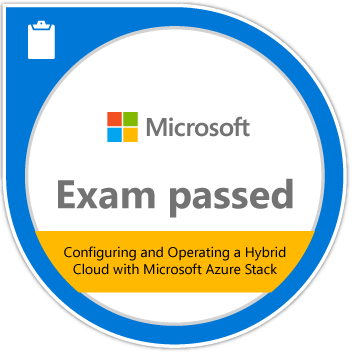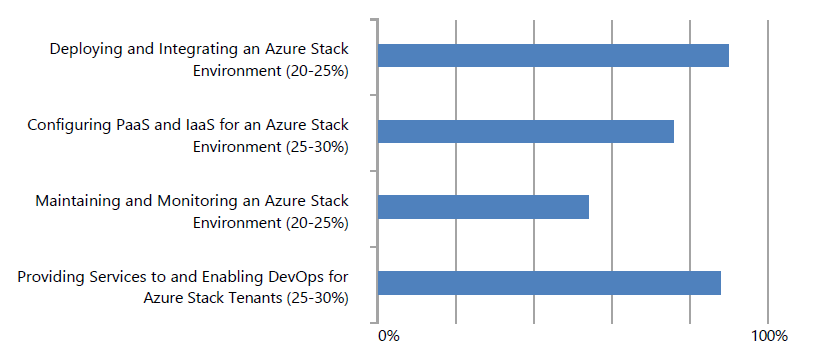Passed the 70-537 AzureStack Operator Exam
I have been part of the beta test group for the AzureStack Operator exam and last week I got the result!


It was quite a difficult exam and you will have to had some hands-on experience on a Azurestack stamp to succeed on this exam!
As you can see on the exam page there are some areas that you need to know about:
Deploying and Integrating an Azure Stack Environment (20-25%)
- Build test environments by using the Azure Stack Development Kit (ASDK).
- This objective may include but is not limited to: use PowerShell commands; install updated ASDK; troubleshoot failed installs; post-deployment registration
- Configure DNS for data center integration.
- This objective may include but is not limited to: configure external DNS name resolution from within Azure Stack; configure Azure Stack DNS names from outside Azure Stack
- Configure connectivity for data center integration.
- This objective may include but is not limited to: manage firewall ports needed at the edge; configure connectivity to the data center; install and renew certificates for public endpoints
- Connect to and perform API-based administration on Azure Stack.
- This objective may include but is not limited to: connect to the stack by using PowerShell; configure client certificates; configure firewall to support remote administration; establish RBAC roles for the Azure Stack fabric; create subscriptions for end users
Configuring PaaS and IaaS for an Azure Stack Environment (25-30%)
- Configure and administer the App Service resource provider.
- This objective may include but is not limited to: configure system; configure source control; configure worker tiers; configure subscription quotas; scale worker tiers and App Service infrastructure roles; add custom software; configure Azure Stack networking security
- Configure and administer database resource providers.
- This objective may include but is not limited to: configure and administer the SQL adapter; configure and administer the MySQL adapter; set up SKUs; set up additional hosting capacity
- Configure and administer IaaS services.
- This objective may include but is not limited to: implement virtual machine images; prepare Linux and Windows images; prepare a custom image; upload an image
Providing Services to and Enabling DevOps for Azure Stack Tenants (25-30%)
- Create and manage quotas, plans, and offers.
- This objective may include but is not limited to: create quotas; configure plans; configure offers; configure delegated offers; create add-on plans
- Manage tenants.
- This objective may include but is not limited to: add new tenants; remove tenants; manage authentication and authorization; establish RBAC roles for the tenant space
- Manage the Azure Marketplace.
- This objective may include but is not limited to: enable Azure Marketplace on Azure Stack; plan new packages; create and publish new packages; download Azure Marketplace items
- Enable DevOps for tenants.
- This objective may include but is not limited to: enable version control for tenants; manage ARM templates; deploy ARM templates; debug ARM templates; use Microsoft Visual Studio Team Services to connect to Azure Stack; use continuous integration and continuous deployment to automate a pipeline that targets Azure Stack
Maintaining and Monitoring an Azure Stack Environment (20-25%)
- Plan and implement a backup-recovery and a disaster-recovery solution.
- This objective may include but is not limited to: back up Azure Stack infrastructure services; perform cloud recovery of Azure Stack, replicate and fail over IaaS virtual machines to Azure; back up and restore PaaS resource data; back up and restore backup and restore of user IaaS virtual machine guest-OS, disks, volumes, and apps
- Manage and monitor capacity, performance, updates, and alerts.
- This objective may include but is not limited to: manage storage; monitor available storage; integrate existing monitoring services; manage public IP address ranges; monitor infrastructure component health; monitor Azure Stack memory, public IP addresses, and storage tenant consumption; apply updates; update system firmware; review and react to alerts
- Manage usage reporting.
- This objective may include but is not limited to: provide access to the usage database; test usage by using the ASDK; collect the usage data by using the Provider Usage API and the Tenant Usage API; investigate the usage time versus the reported time